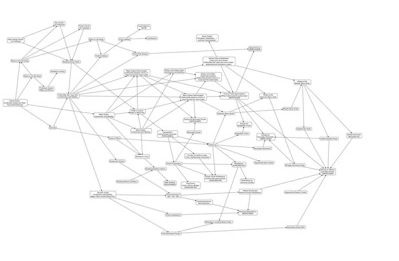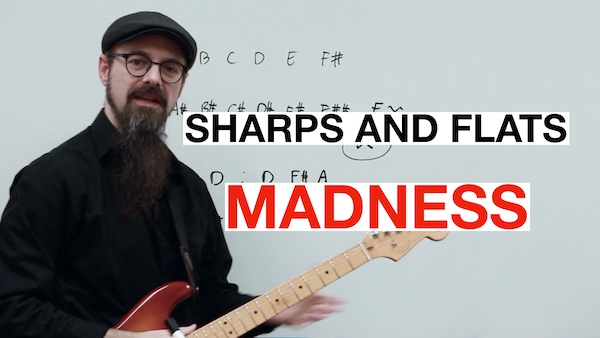Why The Key Of G# Major Is A COMPLETE NIGHTMARE


Why are keys in music so completely confusing?
What is the point of having both sharps and flats when they can both be used to refer to the same thing?
When should you use sharps and when should you use flats?
And what about double sharps and double flats?
All great questions. And they have been plaguing the minds of musicians for hundreds, if not billions of years.
(Ok, that's not true. After all we invented the sharp/flat system just a few hundred years ago. But I've been asked these questions so many times that to me it feels like a billion of year or two...)
But truthfully, the answers are actually simpler than you might think.
Let’s start with the key of C major. The notes are C, D, E, F, G, A, and B. Hopefully, we’re able to figure out, or perhaps you even already know, the distances between these notes in terms of whole steps and half steps.
They are, in case you ‘forgot’: whole, whole, half, whole, whole, whole, half.
So, to spell any other key, we simply take our starting place (let’s use D for example), and count up from there using those distances.
So for the key of D, we get: D, E, F#, G, A, B, C#. Simple, right?
This concept can be used to find the notes in any key you can think of; however - and I think you will agree with me on this - this doesn’t quite answer the question of why we might choose to use sharps or flats, at least in certain situations.
For instance:
Why in a given key we use just sharps or just flats? (There is a very specific practical reason for that)
And there are also certain keys where even this simple concept can start to feel like it’s falling apart.
And what about double sharps or flats?
In the video below, I’ll go over the other simple things you’ll need to keep in mind to solve these issues - once you have watched it, the whole sharp/flat system will make much more sense to you:
If you're interested in furthering your knowledge of music theory on the guitar, I recommend you check out my Complete Chord Mastery guitar course. Understanding chords is one of the most important parts of music theory and this course will give you everything you need to perfect your knowledge of chords and harmony on the guitar.
Video Transcription
Hello Internet, so nice to see you! I got an interesting question about double sharps and double flat. I've been wondering for like an hour now why everybody is saying that the seventh note in G sharp major is F double sharp but not G.
But it's also an F and an F sharp. It makes no sense to me. And by everybody I mean all the different answers on Google. It's so confusing and I haven't even watched the video yet but I just got to know what the actual seventh note of the G sharp major scale is.
I've gotten four answers. G, F double sharp, F sharp, F, which one? Okay so let's see why double sharps and double flat exist, how they come up in music theory, and why F double sharp is not G. The first thing to know is that whenever you spell a scale in the western canon, so major scales, minor scale, harmonic minor, melodic minor, etc, but on scales outside the western canon anything can happen.
But inside the western canon you have always scales of seven notes. So when you spell them you have seven letters and you need to use every letter once and only once. You cannot use the same letter twice and you cannot skip letters.
That's the rule. Now the thing that nobody tells you is why the rule exists. Because everybody tells you do this and then never tell you why. And so people are like why? Okay it's easy. It's actually there's a very really easy answer to that.
It's because when you put those notes down in a score and let's say you have two notes in the scale, you can write those notes as A flat and A sharp. Okay if you have those two notes in the scale both of them will be written in the score in the same position.
One with a flat and one with a sharp. This will be a fairly hard to read, okay? Because we have to put the flats and sharps explicitly every time does not happen and it would be harder to read. When you have those notes in the scale, you have other too much easier solutions here than using the same note with two different alterations.
You could write A-flat and B-flat, so those two notes will be written instead as an A and a B, and indeed maybe those flats will be moved in the key, so you won't have to repeat them every time. Or you could write these as G-sharp and A-sharp, and so those two notes will be written instead as a G-sharp and an A-sharp.
and again it would be in two different places in the score and it would be easier to read. That's why we have this rule. It's for ease of reading. Okay, or at least it started there. When you follow this rule a number of other things happen and they are all good.
So let's say we want to spell the G sharp major scale. Let's say I have, I want to spell the G sharp major scale. I could start from G sharp and do all the calculation but there is an easier way and the easier way is this.
Let's spell the G major scale first. So the scale without the alteration. A G major scale, it's as everybody knows it, is G, A, B, C, D, E, F sharp. Now if you go from G major to G sharp major you add a sharp to all the notes.
Simple as that. The G sharp major scale would be G sharp, A sharp, B sharp, yes there is such a thing as B sharp, C sharp, D sharp, E sharp, yes there is such a thing as E sharp, and F double sharp. Now it's rare to spell it this way.
Most people would prefer to spell this whole scale as an A flat major scale but this spelling does exist or at least some people do use it. There are scores in G sharp and in that case this last note is an F double sharp.
This note will be played on the piano and on the guitar exactly like a G but it's not a G because the G letter is already taken by the G sharp note. Simple as that. Notice a few things. I just added a sharp to every note.
I can do this with scales, I can do this with chords. The fifth chord chord in G is the D major chord and the notes of D major are D, F sharp, A and A. The fifth chord in G sharp, well the only thing I need to do is to add a sharp, it's D sharp major and the notes are D sharp, F double sharp and A sharp.
So you see I just need to add a sharp every time whenever I have this situation. It's easy, it's easier to think about it because you just need to add a sharp. Now of course all the people around you, all the ones around you who have studied anything in music theory know that you don't write double sharps with Yes, that is correct.
I've directed the two sharps just to be clear here on what's happening because I just want to add the sharp, but technically the double sharp symbol is this kind of an x. You will have to write fx or something like that to indicate a double sharp.
Notice this works with sharps but it works also with flats and to demonstrate that I'm going to do it with a and a flat and let's say I have the a major scale and the a flat major scale. I want to write the a flat major scale but I'm starting from the a major scale because for any reason a major it's easier for me.
So I'm writing the a major scale which is a, b, c sharp, d, e, f sharp and g sharp. Now to get to the a flat major scale I just need to add a flat to all the notes. So I'm going to have a flat, b flat, c sharp flat, the sharp and flat will eliminate each other and I have just a natural c, d flat, e flat, f sharp flat is just natural, f g sharp flat is just natural g and you notice that I have now an a flat major scale.
If now I respell everything and harmonically use the g sharp is the same as a flat, a sharp is the same as b flat, b sharp is the same as c and it's very elegant you know it's c sharp is the same as d flat, d sharp the same as e flat, e sharp the same as f and f double sharp the same as g.
Just the names are different the sounds are all the same. We use this rule and spell things this way because it's more consistent and this makes it easier for us to think about those chords. If you want to spell complicated chords you can spell the chord without the alteration first and then add the alteration to all the notes.
Want to spell complicated scale? you spell the scale without the alteration, so you spell, say, a than a flat or g rather than g sharp and then add the alteration just to all the notes, okay? This makes it much easier to think about that and that's why the seventh note in g sharp major is f double sharp and it's not g.
Even if it's played exactly the same, it's called in a different way because it makes it easier to think about that. There is nothing strange about double sharps, they just happen, okay? There are even a few situations where you have triple sharps happening or triple flats, they are very rare, okay?
You typically want to avoid those but occasionally they can happen, okay? But there's nothing strange about that, it's just a notation. Now if you want to know how all this stuff actually sounds and you want to see how all this stuff actually applies to the guitar and you actually want to hear all those sounds and make actual music with that, I recommend you guys have a look at my course Complete Chord Mastery. This is Tommaso Zillio for musictheoryforguitar.com and until next time, enjoy!